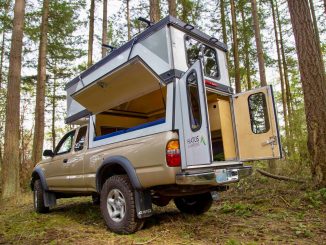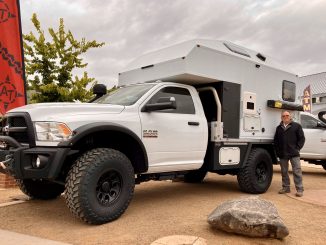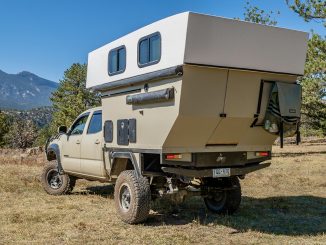
Looking for an expandable, lightweight truck camper that won’t break the bank? Then Jack Younkins’ new truck camper hybrid should fit the bill. Jack’s unique and patended design bridges the gap between a topper shell and a slide-in truck camper, yet weighs only 500 pounds. Better yet, the plans to build this camper is only $500 and can be built by almost anyone who is handy with tools. Jack has been testing the truck camper hybrid prototype this summer and if you happen to live in northern Georgia, you may have been lucky to see it on the road and in area campgrounds. To learn more about this revolutionary design, we spoke with Jack.
Tell us about yourself. Where are you from?
Jack Younkins: I currently reside in Roswell, Georgia just north of Atlanta. I moved to Colorado for a couple of years after college where I chose a truck over a van for my camping adventures. I couldn’t stomach the cost of a camper van back in the year 2000, so I chose a 4WD Toyota pickup that I’m still driving today. My wife and I have six children between the ages of 1 and 15. We did our first cross country trip from Georgia to Oregon in 2016, and have been sold on the rewards of camping as a family ever since. After the 2016 trip, I knew I wanted a slide-in truck camper. I did a lot of research and thought the Capri was our best option. I didn’t pull the trigger on the Capri because I just didn’t feel comfortable with the overall weight and the payload capacity of my half-ton truck. This is what started me down the road of improving the fiberglass truck cap which eventually landed me a patent on my design in 2022.
Your truck camper hybrid is great. What are you calling it?
Jack Younkins: I’m calling it the Truck Camper Hybrid – Makers Edition. I was able to leverage several of the local Makers Spaces in my area to cut the parts via CNC. I am owning the difficult part of engineering and design of the shell system, but I am looking to all the makers out there to build it out and make it better.
How is the camper constructed?
Jack Younkins: This version of the camper is constructed from CNC cut sheets of plywood. I’m using 3/4-inch sheets for the internal framing and 3/8-inch for the framing skin. I’m using Durabak polyurethane to seal the wood on the outside. The outer shell uses the textured version and the inner shell uses the smooth. The engineer I’ve been working with recommended we do the first prototype using wood, and this gave me the idea of making a build kit for all of the DIY makers out there. I am open to other makers out there doing things differently. One example would use a fiberglass skinning option instead of 3/8-inch plywood.

Your rear extension is unique in the industry. How does it work?
Jack Younkins: The slide-out in the video is using polyurethane coated sleds on the bottom to slide along my plastic bed liner. The roof of the outer shell has low profile casters installed. This is something that we will be refining more in the future. I look forward to seeing some other ideas from the makers out there.
So is your camper a truck topper or a slide-in?
Jack Younkins: It’s more a truck topper since it is not fully enclosed like a slide-in camper. There are no tie-downs or mounting points in the bed of the truck, just the bed rail clamps. I designed the shell system to be easier to remove than a slide-in truck camper. My shell system can be removed with two to four camper jacks and then rolled into your garage using furniture dollies and a trailer jack.
What features does the topper have?
Jack Younkins: The main feature of the shell system is the large expansion of space gained with the slide pulled out when parked. This adds 3 feet of enclosed space to my 8-foot bed length. In regards to the width of the truck camper, I am able to go beyond the bed rails for a 7-foot width since the slide is giving the needed support to the back. This is going to be a game changer for smaller trucks like the Ford Maverick which has such a short bed. Being able to push in the slide and put the tailgate up does not interfere with towing or hitch accessories. Another feature is the large hatch door which is part of the inner slide. This will provide a nice covered stand up space beyond the tailgate when it is open. Canvas and netting can be added to the hatch door giving privacy and bug protection.
What does your topper use for electricity? Plumbing?
Jack Younkins: I’ve tailored this build to my family and we like to keep things simple. Mine is built out as a sleeper, and a place to hang out during rain storms. I use a lithium power supply box like the EcoFlow for running the MaxxFan. We keep a bucket potty in the back for late night emergencies, but most of the time we are camping at established campgrounds that have facilities.

How does the bed deploy and work? How large is the bed?
Jack Younkins: I’m using a tri-fold queen 6-inch memory foam mattress for mom and dad. When the slide is extended, I just unfold the mattress between the wheel wells on the plastic bed liner. We will fit a king mattress in our next build using a platform system that covers the wheel wells (like the Decked). We also have two fold up beds on the bed rails that are 25 inches wide by 75 inches long for the younger kids (they work for adults too). Since the roof of the camper is 11 feet long we installed hooks for hammocks for the older kids. This gives us a sleeping capacity of six people.
How much does the camper shell hybrid weigh?
Jack Younkins: Around 500 pounds for the one shown in the video.
Does your topper come with any roof fans or solar panels?
Jack Younkins: I highly recommend a roof fan and the cut out for the fan is in the design. The roof should have no issues supporting a roof rack for things like solar panels.
What are the requirements for the truck?
Jack Younkins: My parametric design should be able to handle just about any pickup truck on the market as long as it has full access to the bed rails. At the moment, this system won’t work for something like the Chevy Avalanche or Tesla Cybertruck that has the side sails.

Any there plans to produce a cabover shell model in the future?
Jack Younkins: Yes. My next build will be a cabover model. I’m really excited about the nose design that my engineer and I came up with.
Is there anything else you’d like to tell us about your camper that you haven’t already?
Jack Younkins: Yes, I would like to talk about the kickstarter project we are launching to get this to market as quickly as possible. I am working on the new website which will spell out all the specifics, but wanted to share a few of my thoughts. I’m trying to stay out of the manufacturing side of this camper shell system and focus more on other areas like the design and IT side. I am currently in communication with several CNC shops that can cut the camper parts, but I am also looking for other makers out there that own a CNC with knowledge on how to cut the parts. This is a great opportunity to earn money with your CNC machine. I’m also looking for builders who maybe don’t have the CNC expertise, but are willing to learn how to assemble these build kits for the buyer that is only interested in buying one.
The web portal I am creating will provide opportunities for makers to provide build kits for the inside. I am looking into creating a very generous affiliate program for people that sign on early. I’m thinking of only charging 500 dollars for a license/parts file during the Kickstarter phase, and if you sign up early enough for a truck model that has not yet been proven out you may qualify as an early adopter and pay nothing. To summarize, be an early adopter and use your own CNC, and you only pay for materials. If you need your parts cut, we are anticipating a cost between $2,000 and $3,000. If you want someone to build it for you we are aiming for a base price starting at $5,000. There’s a lot of opportunity to partner with us and earn money so click on the “I’m interested” button on the website and fill out the form to get yourself in the queue. Finally, if you are not interested in a camper made from wood I am currently looking for contract manufacturers who can offer other options like aluminum or fiberglass.

















Be the first to comment